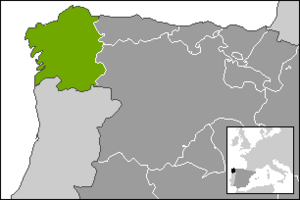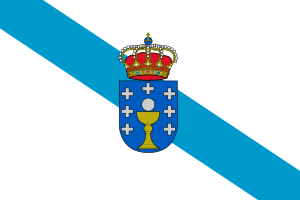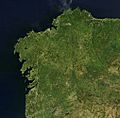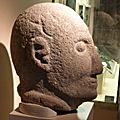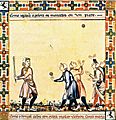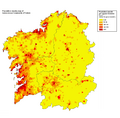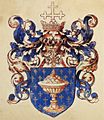Galicia (Spain) facts for kids
Galicia or Galiza is a special part of Spain called a nationality. It became an autonomous community in 1978, which means it has its own government. Galicia is located in the northwest corner of the Iberian Peninsula. It shares its southern border with Portugal. To the east, it borders the Spanish regions of Castile and León and Asturias.
Contents
History of Galicia
Galicia is known as a green land with features that remind people of Celtic cultures.
How Galicia is Governed
Since 1978, when Galicia gained its own government, it has been led by the Xunta de Galicia. This is like its own local government.
From 1990 to 2005, a leader named Manuel Fraga was in charge. After him, Emilio Pérez Touriño became president until 2009. He made Galicia more open and modern. Then, in March 2009, a different political group, the Partido Popular, won the elections. Their new president was Alberto Núñez Feijóo. He was re-elected in 2012, continuing to lead Galicia.
Languages Spoken in Galicia
Galicia has one main language called Galician, or "galego." This language is very similar to Portuguese. In fact, both Galician and Portuguese came from the same original language.
Spanish is also spoken in Galicia. Most people speak Spanish as a second language, after Galician.
Delicious Galician Food
Galicia is very famous for its fishing industry. Because of this, seafood is a super important part of its food culture.
Popular Seafood Dishes
One very popular dish in Galicia is polbo á feira. "Polbo" means octopus, so it's a tasty octopus dish. You can find many restaurants in Galicia that serve amazing seafood.
Images for kids
-
Bronze Age gold helmet from Leiro, Rianxo
-
Palloza houses in eastern Galicia, an evolved form of the Iron Age local roundhouses
-
Castro de Baroña, an Iron Age fortified settlement
-
Miro, king of Galicia, and Martin of Braga, from an 1145 manuscript of Martin's Formula Vitae Honestae, now in the Austrian National Library. The original work was dedicated to King Miro with the header "To King Miro, the most glorious and calm, the pious, famous for his Catholic faith"
-
Partial view of the Romanesque interior of the Cathedral of Santiago de Compostela
-
An illustration of the Cantigas de Santa Maria (13th century)
-
Gothic painting at Vilar de Donas' church, Palas de Rei
-
Maria Pita, heroine of the defense of A Coruña during the English siege of 1589
-
Battle of Vigo Bay, 23 October 1702
-
Battle of Corunna on 16 January 1809
-
Re-enactment of the Battle of Corunna
-
Cliffs of Vixía Herbeira near Cape Ortegal, the highest (613 m) in continental Europe
-
Meadows in Pambre, Palas de Rei
-
'Tres Bispos' peak, Cervantes, Lugo
-
Riparian forest on the banks of the Eume
-
The River Sil and its canyon
-
Electric cars are made in the Citroën French factory in Vigo.
-
An Aer Lingus plane in the Santiago de Compostela Airport.
-
A cruise ship in the seaport of A Coruña.
-
Santiago de Compostela Cathedral, seat of the Archbishop of Santiago of Compostela, and third most important centre of pilgrimage in Christianity.
-
The castle of Pambre, Palas de Rei, which resisted the Irmandiños troops
-
Entroido: Peliqueiros in Laza, allegedly dressed as 16th-century Castilian tax collectors
-
Coat of arms of the Kingdom of Galicia (L'armorial Le Blancq, c. 1560 AD).
-
Fisterra or Cape Finisterre, meaning 'Land's End', one of the westernmost points in continental Europe
-
Tower of Hercules, a Roman lighthouse and a World Heritage monument, A Coruña
-
Queimada, a traditional drink obtained after partially burning local augardente (grappa)
-
Millenarian rock carvings, Laxe dos carballos at Campo Lameiro, in this detail depicts a deer hit by several spears
-
Leña square, Pontevedra
-
Castle and Monastery of San Vicente do Pino, Monforte de Lemos
-
Roman Walls of Lugo, a World Heritage monument
-
The rocky coast of Cabo Silleiro, Baiona
See also
 In Spanish: Galicia para niños
In Spanish: Galicia para niños


